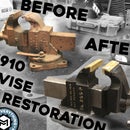Introduction: Easy Floating Shelf - All Wood Bracket. NO WELDING!
In this instructable we will be making a simple floating shelf using a live edge slab, and some plywood with dowels. This will be an all wood construction within welding or steel! You can follow along with this project in the video below, or go into this instructable for a detailed write up.
Supplies
Shelf Material (Slab)
3/4" Plywood
1" Red Oak Dowel
Step 1: Material Selection
For this project we will be using a piece for Beech slab that I milled a while back. This particular piece is about 2 1/8” thick, 20” wide, and 7 inches deep. We will also be using some 3/4” sanded plywood, and 1” solid Red Oak Dowels.
Step 2: Straighten the Back of the Slab
This particular piece is a little out of square, so I need to re cut it on the table saw. I tacked some wood to the front of the slab using brad nails that can be easily removed. I ran it through the table saw and it left me with a nice flat back to sit against the wall.
Step 3: Cutting the Bracket
Its important to size the wall bracket appropriately so it can be hidden behind the slab but also be big enough to hold the dowels. I cut this piece at 1 5/8” using the table saw.
Step 4: Locate and Drill the Dowel Holes
In order to make sure we have a perfect alignment of the wall bracket and the dowels we will drill them simultaneously. We can drill screw the wall bracket directly to the back of the slab and drill straight through it. To stabilize the slab and allow it to be drilled square to the board im going to clamp two pieces of 3/4” scrap wood to either side.
On the drill press im using a 1” forstner bit to drill these holes. Drilling these holes as deep as I possibly can using the press to keep them square to the material. Its important to peck and jog the drill bit when drilling deep like this so the bit doesn’t bind up.
Step 5: Chase the Holes Deeper
Using a spade bit ill drill the holes a bit deeper so the pins can get farther into the material. The hole we drilled with the forstner will act as a guide for the spade bit and should help it drill straight.
Step 6: Resizing the Dowels
The dowel that I got is a very tight fit inside the holes I drilled. To make sure it doesn’t bind and can but put on and taken back off easily I want to reduce the size of the dowels. You could do this a few different ways, like with a lathe or a spoke shave. Im going to keep it simple and use the orbital sander. I want to keep the back of the dowel true to size so its a tight fit inside the plywood, so I used blue tape to keep the sander from hitting those areas.
Step 7: Make a Jig for the Router
Im going to router out the back of the shelf using a pattern bit. In order to get a perfect slot im using scrap wood to build a frame around the back plate. Ill screw this frame to the slab and then take out the back plate to run the router inside it. Whats nice about this is you can keep this frame and use it again over and over if you make more shelves of a similar size.
Step 8: Router the Back of the Shelf.
I am using a 3/4” pattern bit to cut out the inside of the slot. I have to do tin two passes because the slot will be 7/8” deep. Its important to make the slot deeper than the 3/4” plywood is thick. Making the routed slot a little deeper allows the shelf to be pushed back tight against the wall even if there is variation in the wall.
Step 9: Fitting the Back Plate
The router slot will have rounded corners. You can go at them with a chisel to make them square, but I chose to just round them over with the orbital sander so itll fit well
Step 10: Tune and Glue the Pins
The pins are still a little tight so I took a little more time with the sander to make them fit that much better. I also made sure to cut pins to length so they wouldn’t bottom out in the bottom of the hole. Once I had them fitting nice I glued them in to the back plate. I left the backs sticking out a little bit because I wanted to make sure the taper from sanding didnt hit the inside edge of the hole. Im using titebond 3 for glueing the pegs in, and put the bracket into the back of the shelf with spacers so it wouldn’t get glued into place. I let this dry overnight.
Step 11: Trim the Back of the Pins and Test Fit
I waxed the pins so they would slide into and out of the slots in the back of the shelf without binding. I used a small flush cut saw to trim the back of the pins and then sanded them flush.
Step 12: Finish Cut the Sand the Shelf
I used the miter saw to cut the edges of the shelf to its final thickness. Once it was cut I sanded it up to 320 grit using my orbital sander on all sides.
Step 13: Apply Finish
I used clear mineral oil on the shelf on all sides and surfaces. Once it was dry I buffed in some clear paste wax to help protect the wood.
Step 14: Pre Drill the Bracket
Using a counter sink bit I pre drilled some holes in the bracket, I spaced these 16” apart so I could hit studs in the wall.
Step 15: Install the Shelf
I screwed the shelf into the wall using 2” screws, and leveled it. Once the bracket is in the wall you might need to flex the pegs a bit to get the shelf on. If you want to lock the shelf onto the pegs you can drill a single hole in the bottom that will allow a screw to hit the center peg.
Step 16: Final Thoughts
This shelf design is really strong and can be scaled to suite any size material. I put 16lbs on this shelf to test it and it didnt move at all. Try it for yourself and let me know if you have any questions! Thanks! Also vote for me in the woodworking contest! Thanks!

Participated in the
Woodworking Contest













